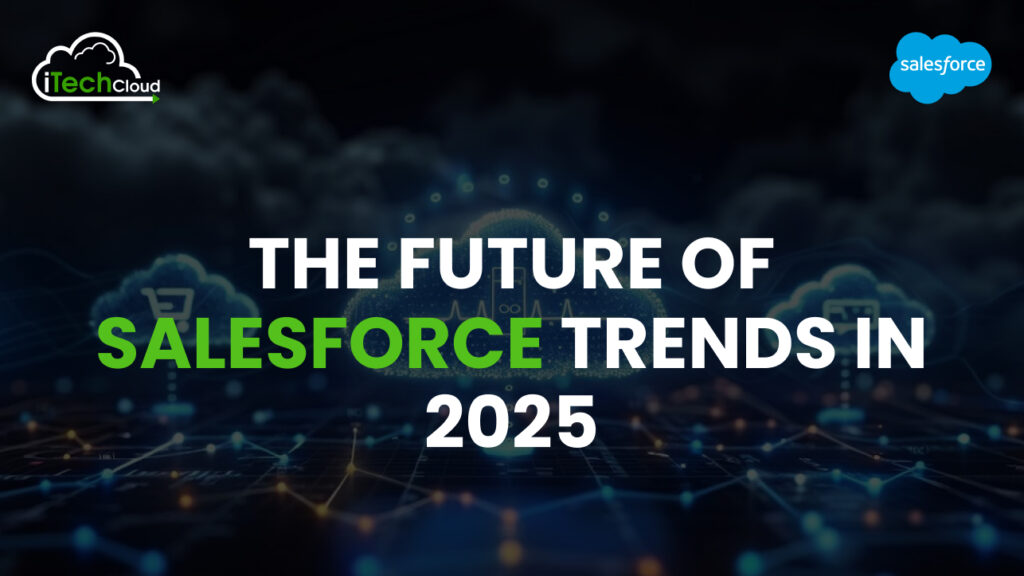The Future of Salesforce Trends in 2025

Salesforce Trends in 2025
Salesforce has been at the forefront of customer relationship management (CRM) for decades, continuously adapting and innovating to meet evolving business needs. As we look to 2025, the Salesforce ecosystem is set to undergo significant transformations, driven by advancements in technology, shifting business priorities, and the growing importance of sustainability. Let’s explore the trends that will shape Salesforce in 2025 and how businesses can harness these innovations to stay competitive.
Table of Contents
1. AI and Einstein GPT Integration
Artificial intelligence (AI) has already revolutionized the way businesses interact with customers, and Salesforce Einstein AI is leading the charge. By 2025, Salesforce is expected to further enhance its AI capabilities, particularly through the integration of Einstein GPT. This cutting-edge technology will enable businesses to:
- Predictive Analytics: Einstein GPT will refine data-driven insights, helping organizations predict customer behavior with greater accuracy. This will allow for proactive decision-making and improved customer satisfaction.
- Automate Routine Tasks: Repetitive tasks like data entry, lead scoring, and email follow-ups will be increasingly automated, freeing up employees to focus on strategic initiatives.
- Personalize Customer Interactions: AI-driven insights will enable hyper-personalized marketing campaigns and customer service experiences, fostering stronger relationships and loyalty.
The integration of Einstein GPT will make AI more accessible, empowering businesses of all sizes to leverage its potential.
2. Data-Driven Decision Making
In the digital age, data is the backbone of effective decision-making. Salesforce Data Cloud is set to play a pivotal role in 2025 by offering real-time insights and analytics capabilities. Key developments include:
- Unified Data Platforms: Businesses will benefit from centralized data platforms that integrate information from various sources, providing a 360-degree view of customers.
- Real-Time Analytics: Enhanced processing speeds and visualization tools will allow organizations to act on insights instantly, improving responsiveness to market changes.
- Predictive and Prescriptive Analytics: Beyond understanding what has happened, businesses will use data to predict future trends and prescribe actionable strategies.
With these advancements, Salesforce will continue to be a critical tool for organizations looking to make informed, strategic decisions.
3. Industry-Specific Solutions
Salesforce’s industry-specific solutions, such as Health Cloud and Financial Services Cloud, have gained traction in recent years. In 2025, these tailored solutions will expand further, offering deeper integrations and enhanced functionalities for specific sectors:
- Healthcare: Advanced patient management tools and telehealth integrations will enable better care delivery and compliance with regulations.
- Finance: Tools for wealth management, risk assessment, and compliance will become more sophisticated, addressing the unique challenges of financial institutions.
- Manufacturing: Enhanced supply chain management and IoT integrations will streamline production and inventory processes.
By addressing the unique needs of different industries, Salesforce will solidify its position as an indispensable partner for businesses across diverse sectors.
4. Low-Code/No-Code Development
The demand for rapid innovation has made low-code and no-code development platforms a priority. Salesforce’s tools like Flow and App Builder are empowering non-technical users to create applications and workflows with minimal coding expertise. By 2025, we can expect:
- Wider Adoption: More businesses will embrace these platforms, democratizing innovation and reducing dependence on IT departments.
- Enhanced User Experience: Intuitive drag-and-drop interfaces and pre-built templates will make it even easier to design custom solutions.
- Faster Time-to-Market: With low-code tools, businesses can quickly adapt to market changes and roll out new functionalities.
This trend will enable organizations to foster a culture of innovation and agility, keeping them ahead in a competitive landscape.
5. Focus on Sustainability
Sustainability is no longer a choice but a necessity for businesses. Salesforce’s Net Zero Cloud has been instrumental in helping organizations track and reduce their carbon footprint. In 2025, sustainability initiatives within Salesforce will likely include:
- Advanced Carbon Tracking: Enhanced tools for monitoring emissions across the supply chain and operations.
- Sustainability Reporting: Improved dashboards and compliance features to meet regulatory and stakeholder demands.
- Green Business Practices: Salesforce will promote eco-friendly practices by integrating sustainability metrics into decision-making processes.
As environmental concerns continue to grow, businesses using Salesforce’s sustainability tools will be better equipped to align with global goals and consumer expectations.
6. Expansion of Hyperforce
Hyperforce, Salesforce’s next-generation infrastructure, has been a game-changer in providing secure and scalable solutions. By 2025, Hyperforce will see broader adoption and improvements, such as:
- Global Reach: Expanded availability in more regions, ensuring compliance with local data regulations and enhancing accessibility.
- Enhanced Security: Advanced encryption and threat detection mechanisms to protect sensitive data.
- Increased Scalability: The ability to support larger volumes of data and users, catering to the needs of growing enterprises.
Hyperforce will empower organizations to operate seamlessly on a global scale while maintaining the highest standards of performance and security.
7. Omnichannel Customer Engagement
Customers today interact with businesses across multiple channels, and Salesforce’s tools are evolving to provide unified experiences. In 2025, omnichannel engagement will be driven by:
- Slack Integration: Deepening integration with Slack to streamline communication between teams and with customers.
- Marketing Cloud Innovations: Enhanced tools for creating cohesive campaigns across email, social media, and other channels.
- Customer Journey Mapping: Improved analytics to track and optimize every touchpoint in the customer journey.
By delivering seamless and consistent experiences, businesses will strengthen customer loyalty and retention.
8. Evolving Partner Ecosystem
Salesforce’s ecosystem of partners and third-party applications has always been a cornerstone of its success. By 2025, the AppExchange marketplace will continue to flourish, offering:
- Diverse Solutions: A growing range of apps tailored to specific business needs, from CRM add-ons to industry-specific tools.
- Collaboration Opportunities: Partnerships with technology leaders to integrate cutting-edge functionalities into Salesforce.
- Community Growth: A thriving community of developers and consultants contributing to the platform’s innovation.
This evolving ecosystem will ensure that Salesforce remains a versatile and adaptable solution for businesses worldwide.
Conclusion
Salesforce’s future in 2025 is bright, marked by advancements in AI, data analytics, industry-specific solutions, and sustainability. Businesses that embrace these trends will optimize their operations and build stronger, more meaningful relationships with customers. As the Salesforce ecosystem evolves, staying informed and proactive will be crucial for organizations looking to leverage its full potential.

